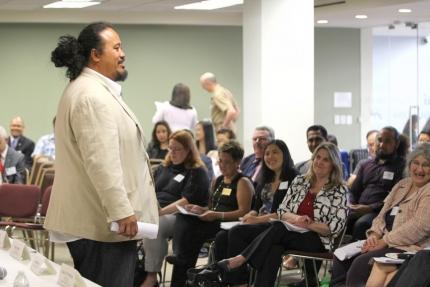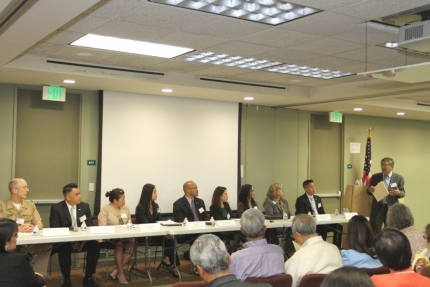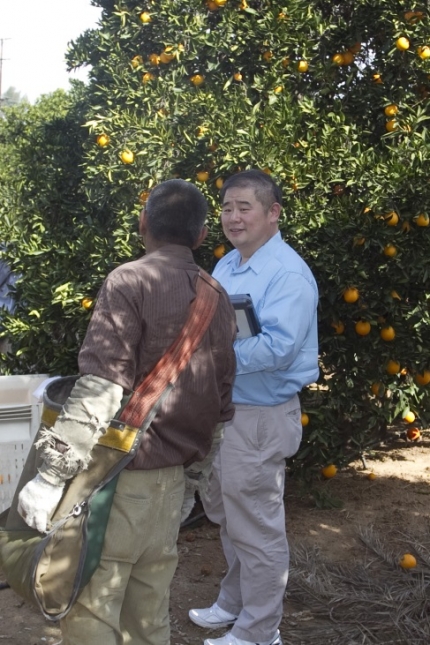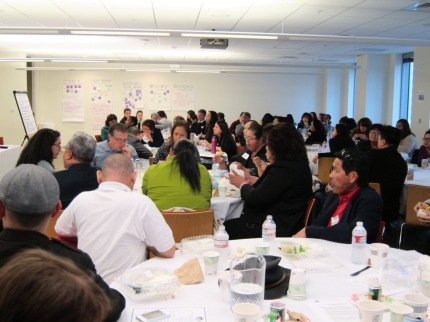Initiative on Asian Americans and Pacific Islanders Blog
RIWG Roundtable in Los Angeles Yields Positive Discussions and Collaboration with AAPI Advocates
Posted by on April 15, 2014 at 12:07 PM EDT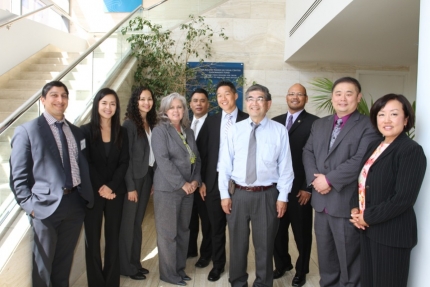
The White House Initiative on AAPIs Regional Interagency Working Group, representing multiple federal agencies, convenes a community roundtable in Los Angeles, April 8, 2014. (by Paul Chang)
Nearly 100 advocates for Asian American and Pacific Islander (AAPI) communities in Los Angeles met face-to-face on April 8 in the first community roundtable in the city hosted by the White House Initiative on AAPIs (WHIAAPI) Regional Interagency Working Group (RIWG).
Asian Americans Advancing Justice—Los Angeles and the Asian Pacific Planning & Policy Council (A3PCON) served as official partners in holding the event and engaging representatives from diverse organizations across southern California.
WHIAAPI Commissioner Sefa Aina welcomed the group and captured the hearts of participants with stories of his roots in local community organizing. Sefa challenged advocates to champion the needs of their communities and encouraged federal representatives to listen to and address those needs.
A lively discussion ensued following the introduction of eleven Los Angeles-based RIWG members from federal agencies such as the U.S. Departments of Labor, Veterans Affairs, Health and Human Services, and my agency, the U.S. Equal Employment Opportunity Commission.
Community advocates needed to know: Who were we, and what could we do for the AAPIs who face discrimination or a lack of access to government services? How do we navigate the process to apply for federal grants?
Dedicated RIWG members rolled out the collective vision of working alongside AAPI community groups to tear down real and perceived barriers in accessing services. Advocates offered ideas on how to work together, whether that is in jointly promoting the visibility of local AAPI issues or explaining (in plain-language) government processes to AAPIs. Members shed light on their legal mandate to remedy disparities in access to employment, education, health, and services for veterans.
The roundtable also included a session on best practices in applying for federal grants. Officials from Grants.gov; the U.S. Departments of Health and Human Services, Labor, Housing and Urban Development; and the Small Business Administration relayed specific grant opportunities along with tips on how to best apply for them, while grantees from the Thai Community Development Center and Advancing Justice shared insight from their experiences. Federal representatives pledged their support to assist advocates through the process.
AAPIs have not traditionally knocked on federal doors. Everyone in the room understood the cultural and linguistic barriers involved. Yet, a collaborative synergy began to circulate in the room as advocates and RIWG members engaged in dialogue and became better acquainted. The RIWG is local, accessible, and here to help. We have already heard from many community members since the event—a beautiful start to a critical partnership in the interest of AAPIs throughout Greater Southern California.
Christine Park-Gonzalez is a Program Analyst for Outreach, Training, and Public Relations for the U.S. Equal Employment Opportunity Commission.
Learn more aboutPūpūkahi I Holomua: Unite to Move Forward
Posted by on April 14, 2014 at 9:28 AM EDT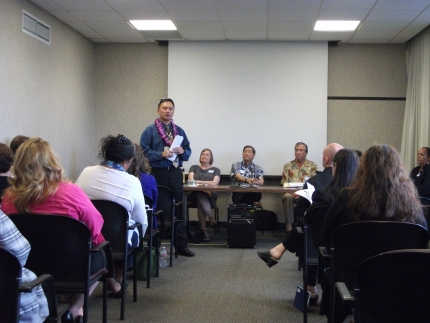
Region 9 RIWG members and community leaders convene in Honolulu to discuss the needs of the AAPI community, April 8, 2014. (by Lorinda Riley)
President Obama’s annual pilgrimage to the islands is a testament to the special draw that so many with a connection to the Islands feel. While Asian Americans and Pacific Islanders (AAPIs) make up nearly 50% of Hawaii’s population, they still struggle with troubling health, education, and economic disparities. When President Obama signed the Executive Order to reestablish the White House Initiative on Asian Americans and Pacific Islanders (WHIAAPI), he stated “no community should be invisible to its government.” It remains critical to open the doors of the federal government to Asian American, Native Hawaiian, and Pacific Islander communities.
With this in mind, the Hawaii Regional Interagency Working Group (RIWG) hosted its first AAPI community roundtable on April 8, 2014. During the roundtable, 86 participants discussed key issues facing the AAPI community, learned about critical federal programs and services, and engaged with federal government officials from Hawaii. Our event, which drew an incredible amount of excitement from the community, brought together community organizations and federal agencies alike. In addition to the more than 20 federal agencies in attendance, community organizations representing language access, religious, education, philanthropy, veterans’ rights, small business, legal aid, civic, and migrant concerns shared their knowledge and experiences.
Our roundtable began with a call to action by Herbert Lee, a Hawaii RIWG member who emphasized the importance of an open dialogue in order for federal agencies to meet the specific needs of the community. Davianna McGregor, a Professor of Ethnic Studies at the University of Hawaii at Manoa, spoke about the U.S. National Parks Service’s Historic Landmarks theme study on AAPIs, which will help government agencies understand the diversity of the AAPI community. Kiran Ahuja, the Executive Director of WHIAAPI, welcomed roundtable participants and shared that the Pacific Islander community faces language access barriers— a key focus area of WHIAAPI’s work.
Breakout sessions provided meaningful dialogue with the AAPI community. Issues discussed included the increased need for small business assistance, especially for veterans, job assistance for the Micronesian community, technical assistance in obtaining grant funding in territories and for community health, and technical issues that prevented Micronesians from accessing health.
The Hawaii Roundtable was successful due to the level of participation that we were able to garner from our community partners—and we thank all of the participants for taking the time to be with us. The RIWG is truly inspired by the dedication and enthusiasm of the community, and we look forward to developing and implementing an action plan to continue the momentum.
Lorinda Riley is an advisor for the White House Initiative on Asian Americans and Pacific Islanders. Herbert Lee is the community outreach and regional planning specialist at the U.S. Department of Labor.
Learn more aboutOpen Hearts and Open Minds: Guam Regional Summit
Posted by on April 11, 2014 at 10:36 AM EDT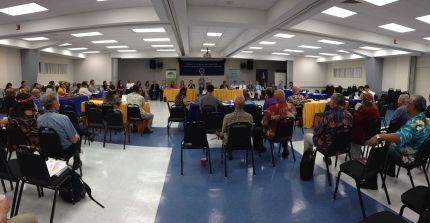
Dozens of federal officials and Pacific Islander leaders convened for the White House Initiative on AAPIs’ Community Tour and Regional Conference at Guam Community College to identify unique challenges Pacific Islanders are facing, April 4, 2014. (by Diana Yu)
On April 3 and 4, 2014, the White House Initiative on Asian Americans and Pacific Islanders (WHIAAPI) and Payu-ta Inc. (a regional umbrella organization of non-governmental organizations) co-hosted the first WHIAAPI regional summit outside the contiguous U.S. When we arrived in Guam, we were reminded of the challenges of island life—distance, limited natural resources, higher cost of living, and smaller economies of scale. Despite these challenges, regional leaders were passionate about tackling these issues, working collaboratively, and doing their part to be part of a regional solution.
We convened in Guam for a dialogue where we were joined by federal officials across a dozen agencies, leaders from national organizations and foundations, and local leaders including Governor Eddie Baza Calvo, Congresswoman Madeleine Bordallo, Guam Legislature Speaker Judith Won Pat, Guam Legislature Vice Speaker BJ Cruz, and WHIAAPI Commissioner Debra Cabrera. The first day comprised of community discussions and visits on topics including: social services; homelessness and veterans; self-determination migration; health disparities; and workforce development and economic development.
The second day was the Regional Conference during which the previous day’s discussions were further enhanced through plenary sessions and workshops. Together, we made recommendations and concrete commitments regarding next steps on topics such as: economic and business development; health equity; education; and housing, homelessness, and veterans issues. The regional summit built off momentum from the Micronesian Non Profit Congress, which convened from March 31 to April 2 with representatives focused on addressing environmental and social injustices. In response to the call for opportunities to strengthen local capabilities, federal representatives also presented a workshop on technical assistance and capacity building on April 2.
While community leaders shared stories of their respective struggles and achieving successful outcomes, federal representatives also highlighted programs, expertise, and technical assistance to address priority needs. Federal officials in particular had an opportunity to learn about the history, natural resources, and spirit of the people as well as the many challenges of island life.
As diverse perspectives were brought forward, we identified shared and common interests. The time on the ground provided an invaluable way to see and hear firsthand the issues Pacific Islanders face every day and the strong commitment to resolve them. We witnessed what can be accomplished by working together. Our time together was meaningful and transformative.
WHIAAPI and other federal agencies committed to taking recommendations back to Washington, D.C. and working collaboratively to tackle some of the long-standing issues. This monumental gathering was a testament to the many stakeholders and concerted efforts over the years to not just give a voice to the communities, but also to engage in a dialogue. With the meeting in Guam, a solid foundation has been laid for improving the quality of life for Pacific Islanders.
Kiran Ahuja is the Executive Director of the White House Initiative on Asian Americans and Pacific Islanders. Lori Faeth is the Acting Assistant Secretary of Insular Areas at the U.S. Department of the Interior.
Learn more aboutSeeing Success in Hawaii: Duncan’s 50th State as Secretary
Posted by on April 10, 2014 at 6:02 PM EDTEd. note: This is cross-posted from ED.gov
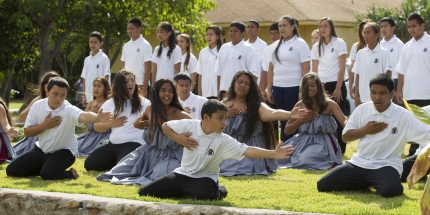
Students at the Ka Waihona o ka Na’auao Public Charter School perform the hula for U.S. Department of Education Secretary Arne Duncan during his visit in Nanakuli, Hawaii, March 31, 2014. (by Eugene Tanner)
Andrea, a senior at Hawaii’s Waipahu High School, came to the U.S. just four years ago after emigrating from the Philippines, but now she’s a proud Waipahu Marauder. From her first day in the classroom, she found the “opportunity to explore” and became interested in cancer research and science.
This fall, thanks to her dedication and the teachers she has at Waipahu, she’ll attend Columbia University on a full-ride scholarship.
Andrea was one of many students Secretary Duncan met during a visit to Oahu earlier this week, which also included stops at Joint Base Pearl Harbor-Hickam for a discussion with military families and a visit to Ka Waihona o ka Na’auao Public Charter School. During Secretary Duncan’s visit to Waipahu, Andrea presented her AP Biology project—“Synthesizing a STAT3 Dimerization Inhibitor Molecule via Retrosynthetic Analysis”—and explained the partnership with the University of Hawaii’s Cancer Center that helped her to pursue her research. “What I’ve learned here is if you want to do something, you can find a way to do it,” she said.
Waipahu High School, located about 20 minutes outside of Honolulu, provides a number of educational programs, with each incoming student picking a “College and Career Theme” to explore. Students at Waipahu High School learn through pathways, which are smaller learning communities that encourage students to identify their career interests and take relevant courses while in high school. They have the opportunity to take classes in programs like creative media, culinary arts, engineering, finance, law and justice administration, and teacher education. Waipahu also offers tuition-free early college courses.
Michael, also a senior at Waipahu, has seen a growth in his abilities since he started as a freshman. Despite starting on the school’s business track “not knowing anything,” Michael has been able to excel. “I was able to make connections with what I was learning...and I saw a change in my grades,” he said. A recent project allowed him to combine his budding business knowledge with his passion for woodwork by designing a business where he could sell the skateboards he creates using natural wood and varnish. The school has enabled him to able to explore art in other areas, too. Michael was able to help paint words like “courage,” “ambition,” “honor” and “integrity”—which he says are “words that encompass who we are”—onto the steps of Waipahu High School.
A focus on relevant, hands-on experiences is a theme among programs at Waipahu. During a tour of the school, students led Secretary Duncan through their research and studies of fish as part of an aquaponics system in the Natural Resources Academy Pathway. Teacher Jeff Garvey, who Secretary Duncan called the “mastermind” behind the aquaponics system, used his private-sector background to build the open-air center and create the chance for students to study aquaponics, which combines fish and plants in a symbiotic, sustainable environment. The program is rapidly expanding as interest grows, including from nearby eighth graders who want to enroll at Waipahu. And despite worries that the system would be hard to maintain, Garvey points to students’ leadership with the center. “Give them ownership, and they take care of it,” he said.
Waipahu serves mostly minority students, and most are from economically disadvantaged backgrounds. Despite those challenges, from 2011-2013, proficiency scores on state tests have risen, as have college-going rates. In that same time, the number of suspensions was nearly cut in half.
Waipahu’s growing success story is one of many throughout the state of Hawaii. The 2013 National Assessment for Educational Progress (NAEP) results indicated that Hawaii was one of the top 5 fastest improving states in the country, with an 8-point increase in math for fourth and eighth grade, a 4-point increase in reading in fourth grade, and a 5-point increase in reading in eighth grade, when compared to 2009 NAEP results.
To accelerate its reform efforts and better support the state’s educators, Hawaii applied for and received a $75 million grant through Race to the Top in 2010. The grant has empowered the state’s leaders to collaborate in new ways and create plans tailored to their needs to prepare students to be ready for college and careers.
Through these funds, the state has developed tools, like a classroom data dashboard and teacher-focused reports, to support teachers and school leaders to use timely and actionable data to improve instruction. Hawaii has also created tools to transition to higher standards and training to develop STEM expertise, and the state and community has supported schools that fall within the Zones of School Innovation to provide students with extended learning time, after-school and summer programs, and comprehensive wraparound services.
And the work is just beginning. State Superintendent Kathryn Matayoshi credited the “catalytic nature of Race to the Top” in enabling the state to try new ideas and create new systems—“an opportunity we’ve taken with both hands”—and acknowledged this is just the start. Gov. Neil Abercrombie echoed that sentiment. “I ask anybody in the state, before you make a judgment about the public schools, see what’s been accomplished in the last three years. By any outside observation, Hawaii public schools are rising, and we’re going to keep on rising,” Abercrombie said.
Hawaii’s progress is thanks to leadership from state and administrative officials, teachers and principals, who have encouraged their students and provided new learning opportunities, even when there have been challenges and tough transitions. “These are profiles in courage,” Secretary Duncan said. “So much of what is going on here can be a model for the nation.”
Watch a short video about Waipahu High School.
Sara Gast is director of strategic communications at the U.S. Department of Education.
Learn more aboutFrom Living in Fear of Deportation to Now Empowering AAPIs
Posted by on April 7, 2014 at 2:57 PM EDTI am proud to be the Assistant District Director at the U.S. Department of Labor, Wage and Hour Division and a member of the White House Initiative on Asian Americans and Pacific Islanders' (WHIAAPI) Regional Interagency Working Group. But this position did not come easily.
Growing up as an undocumented child, I bounced around multiple schools before finally settling in Monterey Park with my grandmother. Even though I grew up in an ethnic enclave such as Monterey Park, my grandmother and I constantly lived in fear of deportation. But my grandmother was hopeful, reassuring me that community leaders were rallying and fighting for people like me.
I received my green card through the 1986 Immigration Reform and Control Act and after becoming a U.S. citizen, I worked as an intern at the U.S. Department of Labor, Wage and Hour Division. As an intern, I worked side-by-side with investigators on many Wage and Hour cases, including the El Monte sweatshop case in 1995, where 72 Thai garment workers were victims of human trafficking and worked for some of the most visible brands in the United States.
I realized that not so long ago, I was the one living in constant fear, but now I was here, helping these victims of human trafficking. I was promoted to be an investigator after graduating from college. Today as the Assistant District Director I continue my work in protecting the American workforce, especially the most vulnerable. I am currently working on programs to better coordinate engagement efforts across federal and regional offices and to share information and resources between agencies and with the AAPI community.
I have also been selected to serve on the WHIAAPI and Federal Asian Pacific American Council challenge team on capacity building, where I am working to find solutions to building and strengthening strategic partnerships between government and the community that are vitally important to all of us.
Paul Chang is the Assistant District Director at the U.S. Department of Labor, Wage and Hour Division and a member of the White House Initiative on Asian Americans and Pacific Islanders’ Regional Interagency Working Group.
Learn more aboutEnergizing Northern California AAPI Communities Through the Regional Interagency Working Group
Posted by on April 2, 2014 at 10:12 AM EDT“What can we do for you?” was the question we, the Region 9 Northern California Interagency Working Group (RIWG) posed to community leaders at last Tuesday’s AAPI Community Roundtable. Our event drew 90 representatives from over 70 organizations serving Asian American and Pacific Islander (AAPI) communities, and provided community leaders the opportunity to set the agenda for our RIWG in the coming year.
After a quick panel introducing the RIWG and its member agencies, we opened the floor to hear from our audience about priority issues, including issues facing Filipino homecare workers, the preference of Korean domestic violence survivors to seek help from community-based organizations instead of shelters, the alarming numbers for AAPI men with HIV, and more.
RIWG members led lively interactive sessions on (1) Healthcare and Social Services, (2) Economic Development and Capacity Building, (3) Worker’s Rights, (4) Civil Rights in Education and (5) Environmental Issues. Questions and concerns from the community filled the room, as each breakout group brainstormed ideas for collaborative projects and solutions. Significantly, the issue of capacity building and funding for community-based organizations and nonprofits repeatedly bubbled up in almost all sessions.
Our co-sponsor, the California Commission on Asian Pacific Islander American Affairs, helped get the word out to our target audience, and together we turned out an impressive array of health care and social service providers, youth organizations, legal and community advocates, academics, women’s groups, foundations, as well as state, federal and congressional officials.
Our other co-sponsor, the San Francisco Bay Area Federal Executive Board, highlighted the amazing work you can get done working collaboratively across federal agencies. We had representatives from the Department of Education, Office for Civil Rights; Department of Health and Human Services; Department of Labor (DOL), Occupational Safety and Health Administration; DOL Women’s Bureau; Environmental Protection Agency; Equal Employment Opportunity Commission; Small Business Administration; Social Security Administration, and DOL Employment & Training Administration.
Our AAPI Roundtable was a great opportunity to build a network amongst community leaders and our agencies. As an RIWG, we learned that if we work together, we can better serve and engage the AAPI community in ways that we had not considered before.
Dr. Tung Nguyen, a member of the President’s Advisory Commission on AAPIs, thanked the community for sharing key issues and taking time to have a dialogue with their local federal agencies. Thanks to the Bay Area community, we, the Region 9 RIWG, are energized to work together and make our voice count on behalf of our local AAPI communities.
Tong Qin is the Director of Asian American and Pacific Islander Outreach and Deputy District Director for the Small Business Administration in the San Francisco District Office and Ana Victoria Fortes is the Program Analyst from the Department of Labor, Women’s Bureau.
Learn more about
- &lsaquo previous
- …
- 15
- 16
- 17
- 18
- 19
- 20
- 21
- 22
- 23
- …
- next &rsaquo
White House Blogs
- The White House Blog
- Middle Class Task Force
- Council of Economic Advisers
- Council on Environmental Quality
- Council on Women and Girls
- Office of Intergovernmental Affairs
- Office of Management and Budget
- Office of Public Engagement
- Office of Science & Tech Policy
- Office of Urban Affairs
- Open Government
- Faith and Neighborhood Partnerships
- Social Innovation and Civic Participation
- US Trade Representative
- Office National Drug Control Policy
categories
- AIDS Policy
- Alaska
- Blueprint for an America Built to Last
- Budget
- Civil Rights
- Defense
- Disabilities
- Economy
- Education
- Energy and Environment
- Equal Pay
- Ethics
- Faith Based
- Fiscal Responsibility
- Foreign Policy
- Grab Bag
- Health Care
- Homeland Security
- Immigration
- Innovation Fellows
- Inside the White House
- Middle Class Security
- Open Government
- Poverty
- Rural
- Seniors and Social Security
- Service
- Social Innovation
- State of the Union
- Taxes
- Technology
- Urban Policy
- Veterans
- Violence Prevention
- White House Internships
- Women
- Working Families
- Additional Issues
